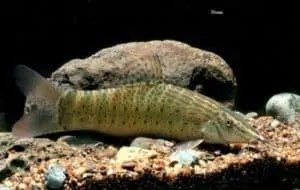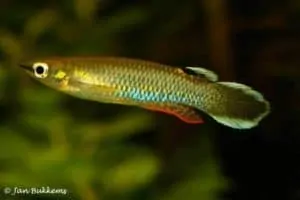Devario devario
Devario devario was first described by Hamilton in 1822. At that time this species was given the name Cyprinus devario. Later this species got its current name: Devario devario. In addition to these two names, some other synonyms have been formed for this species. Their common name is Sind Danio.
Description
Devario devario has a streamlined body with a blue-to-blue-green colour. Yellow to orange spots can be seen on the body. The scales on the backs of these fish gleam in the light. A yellow-to-orange horizontal stripe runs halfway up the body to the caudal fin. A dark blue-to-blue-green horizontal line is visible on the caudal fin. The other fins are yellow.
The sex difference can be made by looking at the size of the fish. The females are slightly larger and fuller-bodied than the males.
Distribution and Habitat
Devario devario can be found in India, Nepal, Bangladesh, and Pakistan. Here they have been observed in the rivers Siyom, Torsa, and Teesta, among others.
These fish are observed in water with moderate currents in their natural habitat. Here the substrate consists of sand, gravel and boulders. In addition, few plants are observed in these rivers. Research in the Siyom River has shown that the fish have to deal with large fluctuations in temperature. They live at temperatures of 9°C to 11°C in winter, while in summer the temperature can rise to 20°C to 26°C. During the year the pH value is relatively constant between 6.0 and 7.5. The alkalinity is slightly lower in winter (40-44 mg/l) than in summer (42-48 mg/l).
Diet
In its natural habitat, Devario devario has an almost exclusively carnivorous diet. Because of this, only carnivorous food should be offered in the aquarium. In aquariums, the fish are not difficult to get to eat. They accept dry, frozen and live food. Sufficient variety in the diet, on the other hand, does ensure healthier and better-colored fish.
The aquarium
The aquarium is best set up as a hillstream aquarium. Therefore, stones are recommended as decoration material. A substrate of sand and gravel mimics the natural conditions best.
The water in the aquarium does not have to have a strong current. In nature, this species occurs in streams with a moderate to weak current. However, there must be a lot of oxygen in the water. This high oxygen level can be achieved by creating a lot of movement on the water’s surface. In addition to being rich in oxygen, the water must also be very pure and crystal clear. Deverio devario is not very resistant to waste products in the water. A good filter and many water changes are therefore a must.
These fish are not aggressive. They will therefore not bother other species. Nevertheless, it is not recommended to keep Devario devario together with fish species that are very shy and need calm tank mates. This Devario species is an active swimmer. The fish can become very busy, especially during feeding. Small conflicts can occur between themselves as fish compete for a better place in the hierarchy. However, these conflicts are relatively small and never lead to injuries.
Breeding Devario devario
Devario devario is an egg-scatterer. As a result, the yield in a community aquarium is very low. It is therefore advisable to set up a separate breeding aquarium for breeding. This breeding aquarium must be set up in such a way that the parents cannot eat their own eggs. For this, marbles can be placed on the bottom. Placing a grid can also provide a higher yield. Other possibilities are spawning mops or planting fine-leaved plants such as Java moss.
The water in the breeding aquarium should all be at the recommended values except for the temperature. The temperature should be slowly increased to a temperature of 24-26 °C. In addition, it is necessary to create a high oxygen level in the water. This can be achieved by using an air stone and a strong filter. Some current is also recommended. It is also recommended to dim the light of the aquarium.
When the aquarium is set up and the fish are ready to mate, the parents can be introduced. After 24 hours the fish will breed and after 48 hours the parents should be taken out. After 24 to 36 hours the eggs will hatch. The young are still very small at the moment. The young Devario devario should therefore also be fed with paramecia. Artemia nauplii or microworms can be given when the fry are slightly larger.
Author
Rick
Copyright images
References
- Acharjee, M. L., & Barat, S. (2013). Ichthyofaunal diversity of Teesta River in darjeeling himalaya of west bengal, India. Asian Journal of Experimental Biological Sciences, 4(1), 112-122.
- Bagra, K., & Das, D. N. (2010). Fish Diversity of River Siyom of Arunachal Pradesh India: A Case Study. Our nature, 8(1), 164-169.
- California Academy of Sciences. (n.d.). Retrieved from http://researcharchive.calacademy.org/research/ichthyology/catalog/fishcatmain.asp
- Devario devario – Bengal Danio (Danio devario; Devario cyanotaenia). (n.d.). Retrieved from http://www.seriouslyfish.com/species/devario-devario/
- Dey, A., & Sarkar, D. (2015). In search of Ichthyofauna diversity: A study on Torsa river in Cooch Behar district of West Bengal. Int. J. Pure App. Biosci, 3(4), 235-241.
- Goswami, U. C., Basistha, S. K., Bora, D., Shyamkumar, K., Saikia, B., & Changsan, K. (2012). Fish diversity of North East India, inclusive of the Himalayan and Indo Burma biodiversity hotspots zones: A checklist on their taxonomic status, economic importance, geographical distribution, present status and prevailing threats. International Journal of Biodiversity and Conservation, 4(15), 592-613.















Reviews
There are no reviews yet.